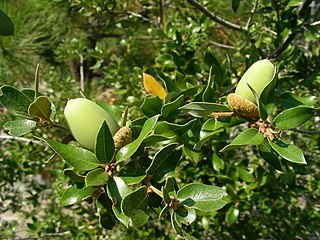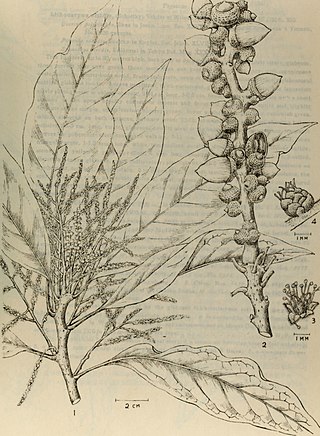
Lithocarpus is a genus in the beech family, Fagaceae. Trees in this genus are commonly known as the stone oaks and differ from Quercus primarily because they produce insect-pollinated flowers on erect spikes and the female flowers have short styles with punctate stigmas. At current, around 340 species have been described, mostly restricted to Southeast Asia. Fossils show that Lithocarpus formerly had a wider distribution, being found in North America and Europe during the Eocene to Miocene epochs. The species extend from the foothills of the Hengduan Mountains, where they form dominant stands of trees, through Indochina and the Malayan Archipelago, crossing Wallace's Line and reaching Papua. In general, these trees are most dominant in the uplands and have many ecological similarities to the Dipterocarpaceae, the dominant lowland tree group. These trees are intolerant of seasonal droughts, not being found on the Lesser Sunda Islands, despite their ability to cross numerous water barriers to reach Papua.

Quercus chrysolepis, commonly termed canyon live oak, canyon oak, golden cup oak or maul oak, is a North American species of evergreen oak that is found in Mexico and in the western United States, notably in the California Coast Ranges. This tree is often found near creeks and drainage swales growing in moist cool microhabitats. Its leaves are a glossy dark green on the upper surface with prominent spines; a further identification arises from the leaves of canyon live oak being geometrically flat.

Notholithocarpus densiflorus, commonly known as the tanoak or tanbark-oak, is a broadleaf tree in the family Fagaceae, and the type species of the genus Notholithocarpus. It is native to the far western United States, particularly Oregon and California. It ranges from 15–40 meters in height, with a trunk diameter of 60–190 centimeters.
Lithocarpus beccarianus is a tree in the beech family Fagaceae. It is named for the Italian botanist Odoardo Beccari.
Lithocarpus bennettii is a tree in the beech family Fagaceae. It is named for the English botanist John Joseph Bennett.
Lithocarpus blumeanus is a tree in the beech family Fagaceae. It is named for the German-Dutch botanist Carl Ludwig Blume.
Lithocarpus caudatifolius is a tree in the beech family Fagaceae. The specific epithet caudatifolius is from the Latin meaning "leaf with caudate apex".
Lithocarpus clementianus is a tree in the beech family Fagaceae. It is named for Governor Cecil Clementi Smith of the Straits Settlements.
Lithocarpus confertus is a tree in the beech family Fagaceae. The specific epithet confertus is from the Latin meaning "crowded", referring to the inflorescences and infructescences.
Lithocarpus conocarpus is a tree in the beech family Fagaceae. The specific epithet conocarpus is from the Greek meaning "cone fruit", referring to the acorn shape.
Lithocarpus daphnoideus is a tree in the beech family Fagaceae. The specific epithet daphnoideus is from the Greek meaning "like Daphne", referring to the genus Daphne and its leaves.
Lithocarpus dasystachyus is a tree in the beech family Fagaceae. The specific epithet dasystachyus is from the Greek meaning "thickly hairy spike", referring to the inflorescence.

Lithocarpus elegans is a tree in the beech family Fagaceae. The specific epithet elegans is from the Latin meaning "elegant", referring to the acorns and cupules.
Lithocarpus encleisacarpus is a tree in the beech family Fagaceae. The specific epithet is from the Greek meaning "enclosed fruit", referring to the acorns and cupules. The cupule is not fused to the nut though and often becomes irregularly dehiscent. The degree to which the nut is enclosed by the cupule varies across its geographic range. Trees in Lithocarpus are commonly known as the stone oaks and differ from Quercus primarily because they produce insect-pollinated flowers.
Lithocarpus ferrugineus is a tree in the beech family Fagaceae. The specific epithet ferrugineus is from the Latin meaning "red-brown", referring to the acorn's indumentum.
Lithocarpus gracilis is a tree in the beech family Fagaceae. The specific epithet gracilis is from the Latin meaning "slender", referring to the twigs.
Lithocarpus jacobsii is a tree in the beech family Fagaceae. It is named for the Dutch botanist Marius Jacobs. Trees in Lithocarpus are commonly known as the stone oaks and differ from Quercus primarily because they produce insect-pollinated flowers.
Lithocarpus kalkmanii is a tree in the beech family Fagaceae. This species is named for the Dutch botanist Cornelis Kalkman.

Lithocarpus lucidus is a tree in the beech family Fagaceae. The specific epithet lucidus is from the Latin meaning "shining", referring to the acorn and leaf surface.
Lithocarpus melataiensis is a tree in the beech family Fagaceae. It is named for, and native to, Bukit Melatai mountain in Sarawak, Borneo.




